10 Horror Movies With the Most Iconic Posters Ever Made
Horror movie posters have a unique ability to capture the essence of terror with just one image. From chilling silhouettes to haunting visuals, these iconic designs set the tone for the fear and suspense that unfold on screen. Whether it’s the ominous figure of a killer or a disturbing symbol of the supernatural, these posters evoke feelings of dread before the first scene even begins.
This post may contain affiliate links, which helps keep this content free. Please read our disclosure for more info.
Halloween (1978)
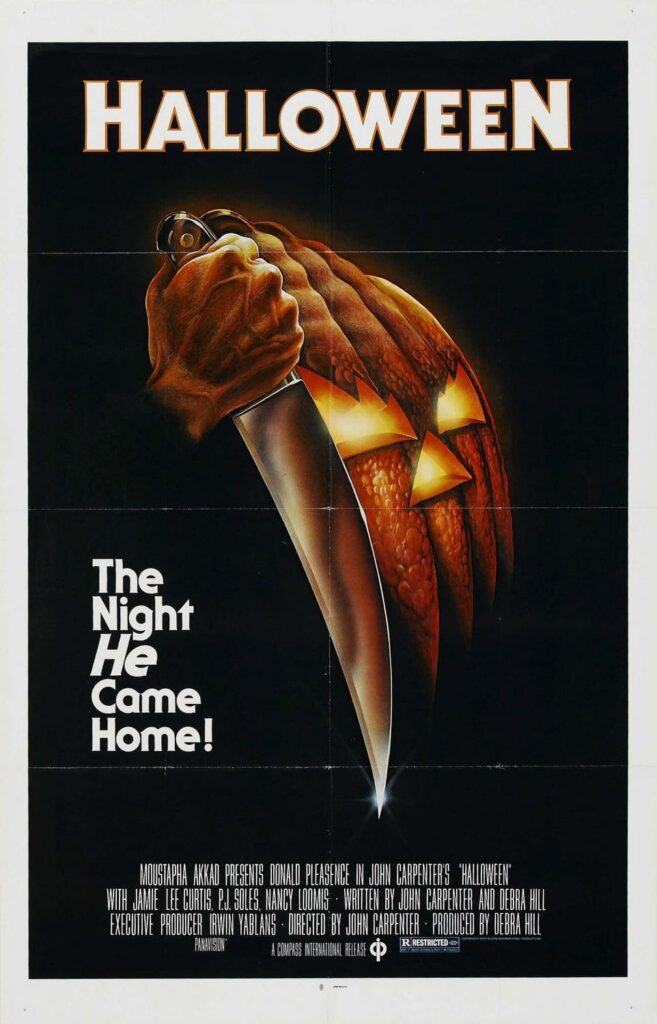
The poster for Halloween is one of the most instantly recognizable in horror film history. It features the eerie silhouette of Michael Myers, the film’s masked killer, standing in front of a glowing jack-o’-lantern. The iconic tagline, “The night HE came home!” speaks to a haunting and mysterious presence, creating an air of suspense and fear. The stark contrast between the orange pumpkin and the black background helps to heighten the ominous tone, using simplicity to achieve maximum impact. The silhouette of Michael Myers is especially chilling, as it hints at a threat that is all around, yet not fully understood. The simplicity of the design allows the viewer to focus on the concept of fear without any need for unnecessary details or gore.
This poster embodies the power of minimalism in horror marketing. It doesn’t rely on showing the killer’s face or graphic imagery to instill fear, but instead, plays with our expectations and imaginations. Michael Myers, an unknowable figure, looming in the background, becomes a symbol of terror in itself. The tagline adds further intrigue by implying a return, as though Myers’ actions are part of something larger, making the movie feel like an event and not just a typical slasher film. The poster stands as a masterclass in how visuals and text can set the mood for a film, drawing viewers in with subtlety and building anticipation for the terrifying tale that follows.
Jaws (1975)
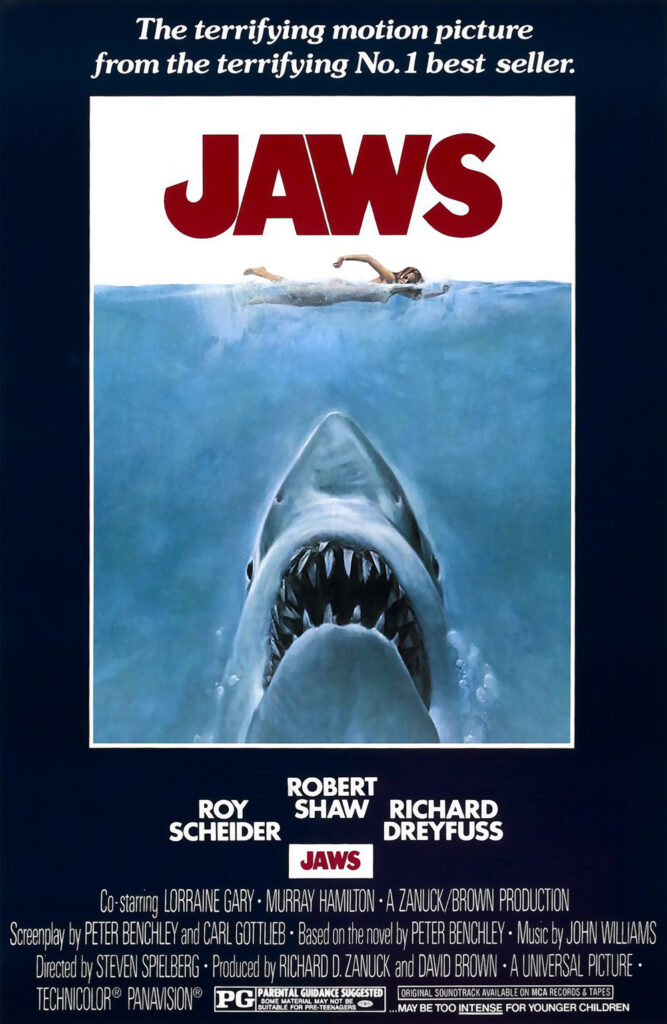
The Jaws poster is iconic for its combination of simplicity and pure terror. It shows a giant shark descending on a swimmer, poised to strike, with the swimmer’s desperate vulnerability becoming the focal point of the image. The massive shark, barely visible beneath the water’s surface except for its open mouth, heightens the dread. The poster expertly uses the primal fear of the unknown and the terrifying unpredictability of what lurks beneath the surface. This visual cues into our natural fear of the ocean, a vast and mysterious place that seems to harbor endless dangers. The tagline, “Don’t go in the water,” further intensifies the fear, turning an ordinary activity into an ominous threat.
What makes this poster so memorable is its ability to visually communicate the core of the film without showing much of the actual threat. The shark is the epitome of a menacing force, but the poster cleverly focuses on the swimmer’s helplessness. The tension in the image creates an uneasy sense of anticipation, forcing viewers to imagine the horror that is about to unfold. The minimalism of the design, with its deep blues and whites, suggests the vast, uncontrollable nature of the ocean, and the only thing more frightening than the creature itself is the realization that there’s nowhere to escape. This poster, through its clever simplicity, immediately sets the stage for the heart-pounding terror that Jaws brought to the big screen.
The Exorcist (1973)
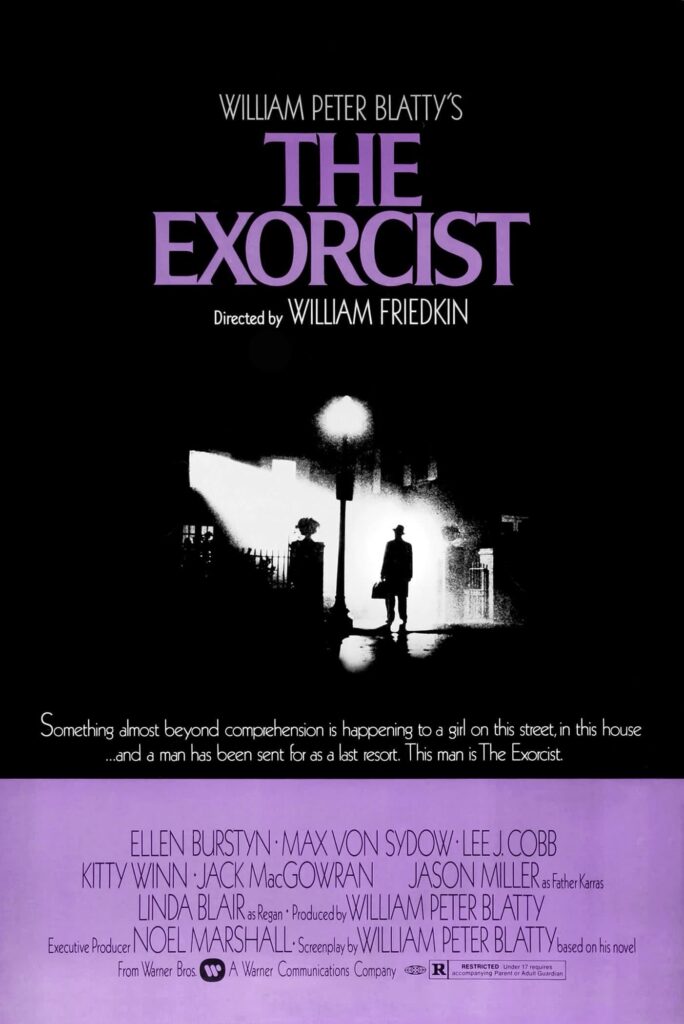
The Exorcist poster is one of the most unsettling and haunting in film history, and it perfectly encapsulates the chilling terror of the film. Featuring a darkened house with a figure standing at the top of the stairs, the poster’s use of purple font draws attention to the supernatural elements of the story. The figure, almost indistinct in silhouette, slowly advances toward the viewer, creating an overwhelming sense of dread. The house, shrouded in darkness, suggests that something evil is lurking within, while the haunting figure approaching the door invites a feeling of impending doom. The purple hue used in the text contrasts sharply with the black background, signaling that something unnatural and terrifying is about to unfold. The visual narrative draws on the viewer’s deepest fears of the unknown, creating a sense of terror that is both personal and universal.
The poster’s simplicity in showing very little is what makes it so effective. It leaves much to the imagination, invoking the same type of fear that the film explores: the horror of what we cannot see, but feel. It avoids showing the actual possession, focusing instead on what might happen, letting the viewer’s own fears take over. The inclusion of the figure walking toward the house gives the impression that the viewer is about to step into a world where nothing is safe or certain, inviting them to experience the spine-chilling atmosphere of the film. This chilling, minimalist approach turned the poster into a lasting symbol of one of the most terrifying horror films ever made.
The Shining (1980)
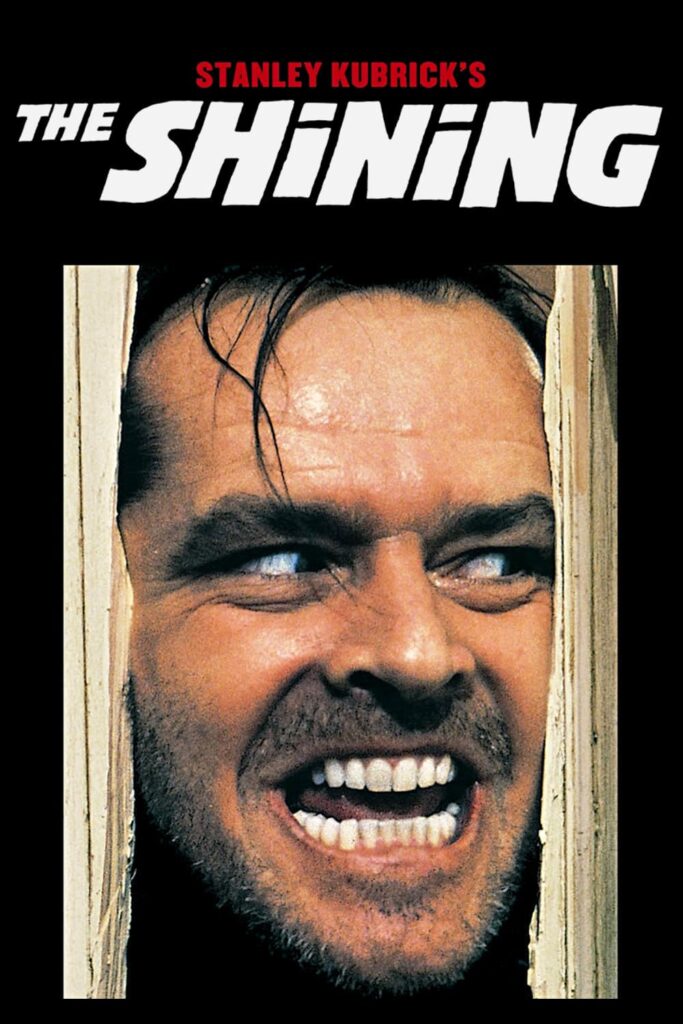
The poster for The Shining is a haunting visual that perfectly captures the psychological tension and terror that the film delivers. Featuring Jack Nicholson’s face, half-frozen in a manic expression, it’s an image that instantly connects to the film’s most memorable moments. His wide-eyed stare peeking through a door is both unnerving and mesmerizing, capturing the essence of his descent into madness. The tagline “Here’s Johnny!” further solidifies the poster’s connection to the most famous scene in the film, and the stark white background contrasts sharply with Nicholson’s face, enhancing the sense of isolation and intensity.
This poster is effective because it doesn’t need to show much to imply horror. The focus is on the face of a man unraveling, which serves as a window into the chaos that is unfolding inside the Overlook Hotel. The combination of Nicholson’s psychotic expression and the minimalist design communicates a chilling, slow-building tension, which makes this one of the most iconic and enduring images in horror film marketing. It emphasizes psychological terror over physical danger, leaving viewers to wonder what horrors await within the film itself.
Nightmare on Elm Street (1984)
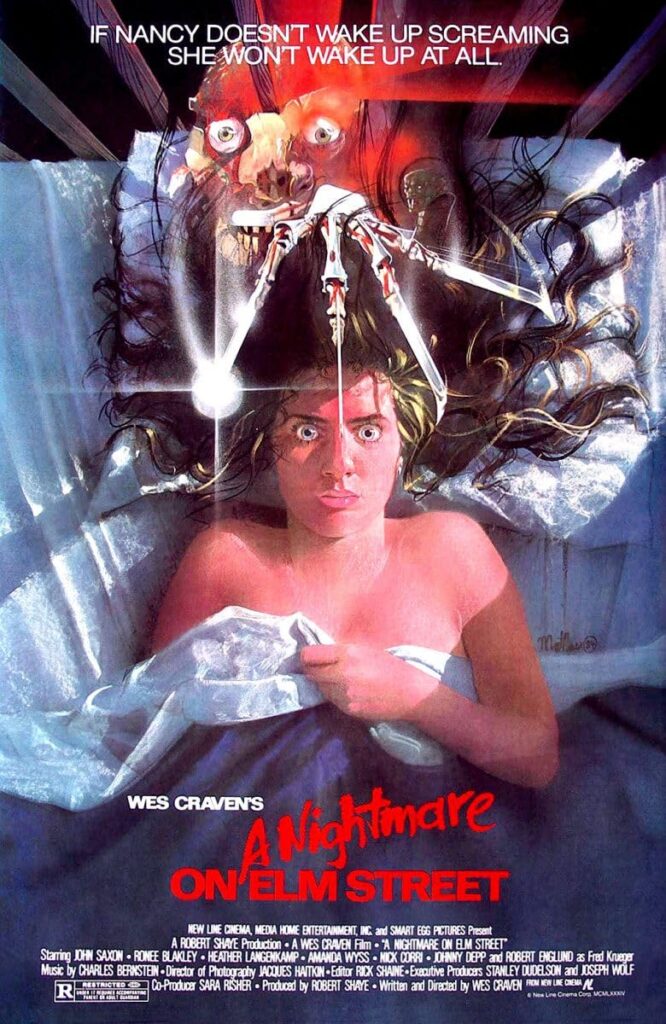
The Nightmare on Elm Street poster presents a visually striking image of Freddy Krueger’s gloved hand emerging from a pool of blood, claws raised and ready to strike. This sinister image is complemented by the tagline, “If Nancy doesn’t wake up screaming, she won’t wake up at all,” which directly references the chilling premise of the film. The deep red tones on the poster reinforce the blood-curdling sense of danger, while the image of Freddy’s glove creates an immediate connection to his signature weapon.
What makes this poster so iconic is the way it draws viewers into Freddy’s nightmarish world. The image of the gloved hand, with its signature razor-sharp claws, is instantly recognizable, and the design of the poster hints at the surreal, dream-like quality of the film. The hand emerging from the darkness symbolizes the inescapable nature of Freddy’s power, adding to the sense of hopelessness and fear that permeates the film. This poster skillfully plays on the fear of not being able to escape, even in your own dreams.
Psycho (1960)
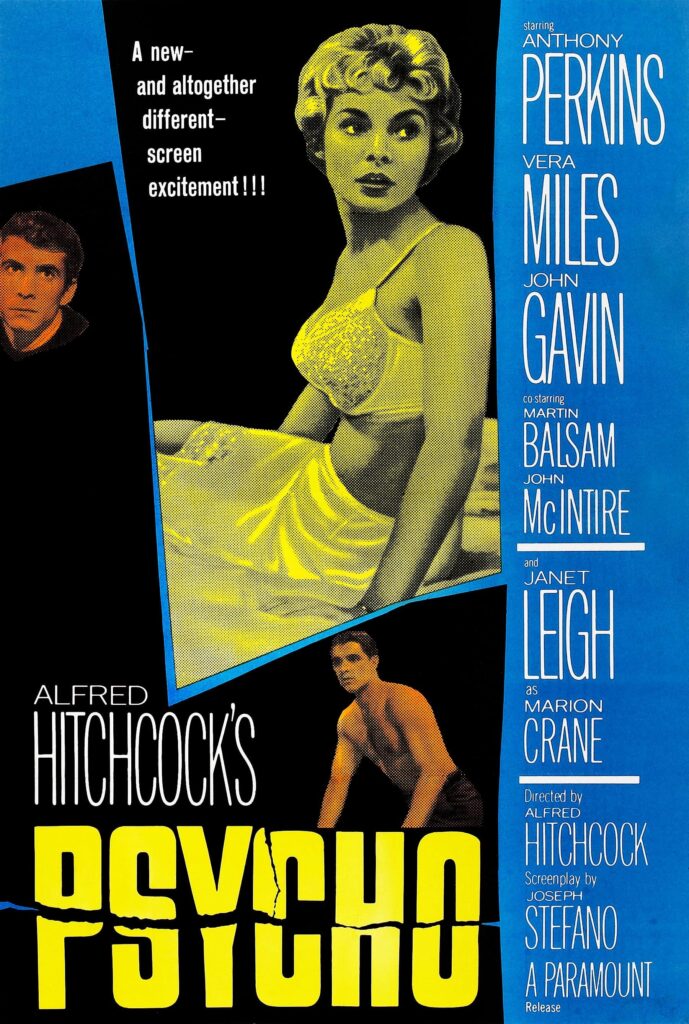
The Psycho poster is another masterpiece of simplicity, using a minimalist design to convey a deep sense of terror. Featuring a close-up of a woman’s eye, it becomes an ominous metaphor for the voyeuristic nature of the film. The tagline “A new – and different – kind of screen excitement” draws attention to the shocking and groundbreaking nature of the film’s content at the time. The eye, wide open in fear, echoes the sense of helplessness and terror that the film’s protagonist feels as she faces the unknown.
The poster’s use of black and white contrasts, combined with the unsettling image of the eye, helps to create an eerie atmosphere. It’s a simple but effective design that leaves much to the imagination, allowing the viewer’s mind to fill in the gaps and create their own horrors. This imagery speaks to the primal fear of being watched, a theme that runs deep throughout the film. The eye on the poster is not just a body part, but a representation of the vulnerability and impending doom that lurk in the story.
The Texas Chain Saw Massacre (1974)
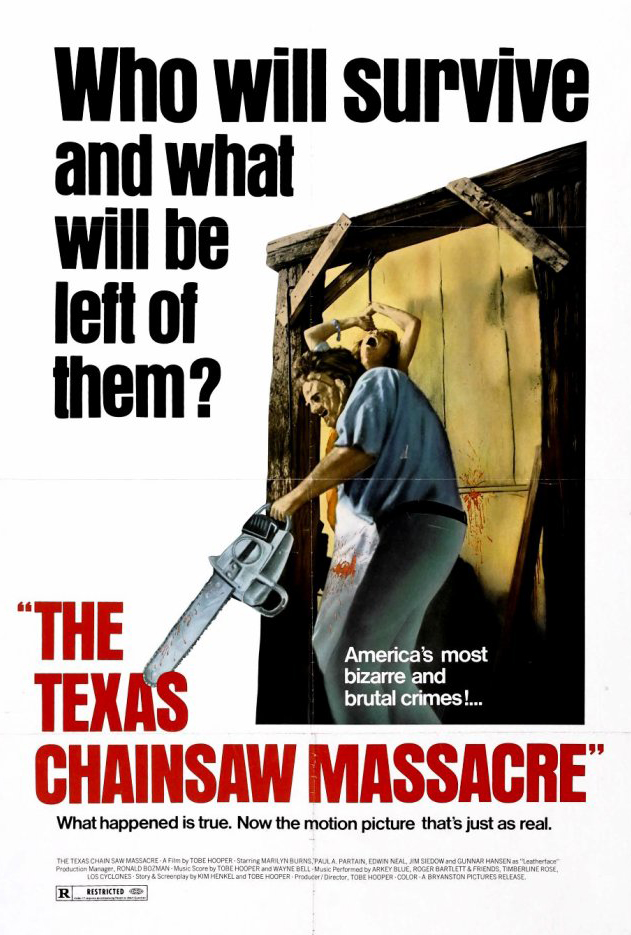
The Texas Chain Saw Massacre poster is a haunting depiction of a chainsaw-wielding man, his face obscured, creating an instant association with terror and violence. The starkness of the image, paired with the tagline “Who will survive and what will be left of them?” conveys a sense of brutality and imminent danger. The poster’s minimalistic use of imagery helps to amplify the horror, allowing the viewer to focus solely on the looming threat of the killer and the unknown horrors that await.
What makes this poster so iconic is its ability to create fear through suggestion rather than explicit violence. The chainsaw is an immediate symbol of terror, and the lack of a clear image of the killer only adds to the suspense and dread. It’s a perfect representation of the raw and unrelenting nature of the film, where the focus is less on the plot and more on the primal fear of survival. This poster has become synonymous with the slasher genre, standing as one of the most iconic and disturbing images in horror film history.
Alien (1979)
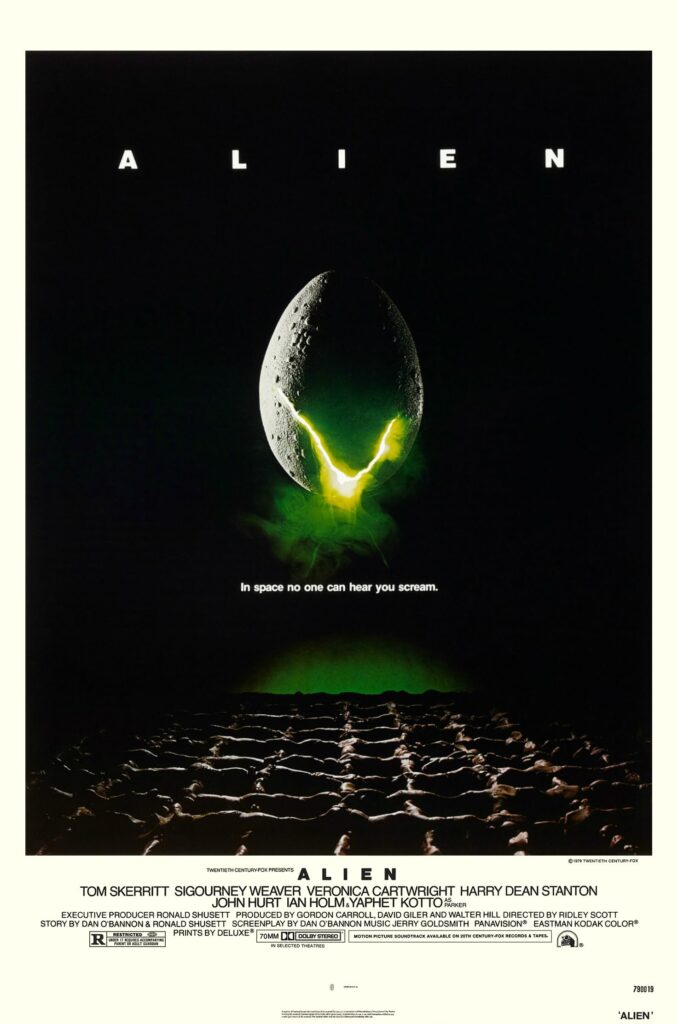
The Alien poster is a chilling image that hints at the horror to come, with a dark silhouette of an alien egg against a stark black background. The tagline “In space, no one can hear you scream” encapsulates the terrifying isolation and helplessness that the characters experience in the film. The visual of the egg, glowing with an eerie green hue, represents the alien presence that is about to infest the ship, suggesting the biological horror that is to come.
The poster works so well because it presents the alien not as a fully realized threat but as something much more terrifying: an unknown force that is yet to be unleashed. The glowing egg evokes both curiosity and fear, suggesting that the true horror lies in what is hidden inside. The tagline emphasizes the helplessness of the characters, adding a layer of isolation to the fear, making the viewer feel as though they, too, are trapped in the claustrophobic terror of space.
The Blair Witch Project (1999)
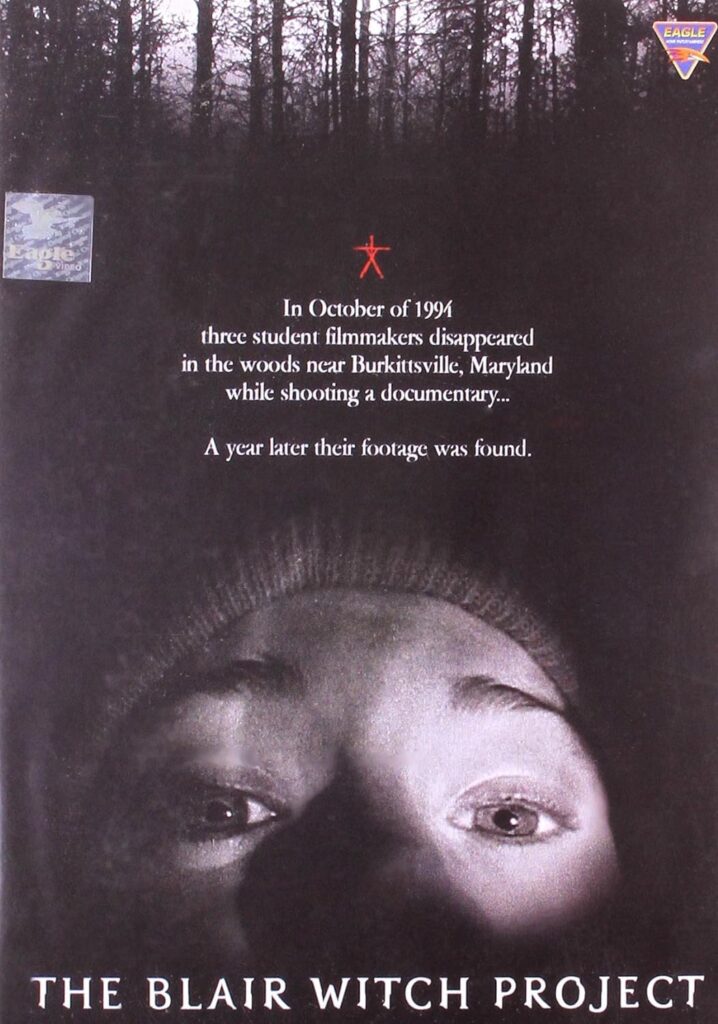
The poster for The Blair Witch Project is a haunting and simple image of a set of handprints smeared on a wooden post. The absence of any obvious horror elements makes the poster feel eerie and unsettling. The tagline, “In the woods, you won’t be coming back,” perfectly encapsulates the sense of dread that the film instills. The rustic simplicity of the poster adds to the rawness and authenticity of the film, which was marketed as real footage.
The design of the poster is effective because it plays on the fear of isolation and the unknown. There are no visible monsters or gruesome images, just a simple set of handprints that suggest something sinister has happened. It builds tension through ambiguity, making viewers wonder what exactly is lurking in the woods. This understated approach to horror made the film’s marketing campaign one of the most successful and innovative in horror history.
The Thing (1982)
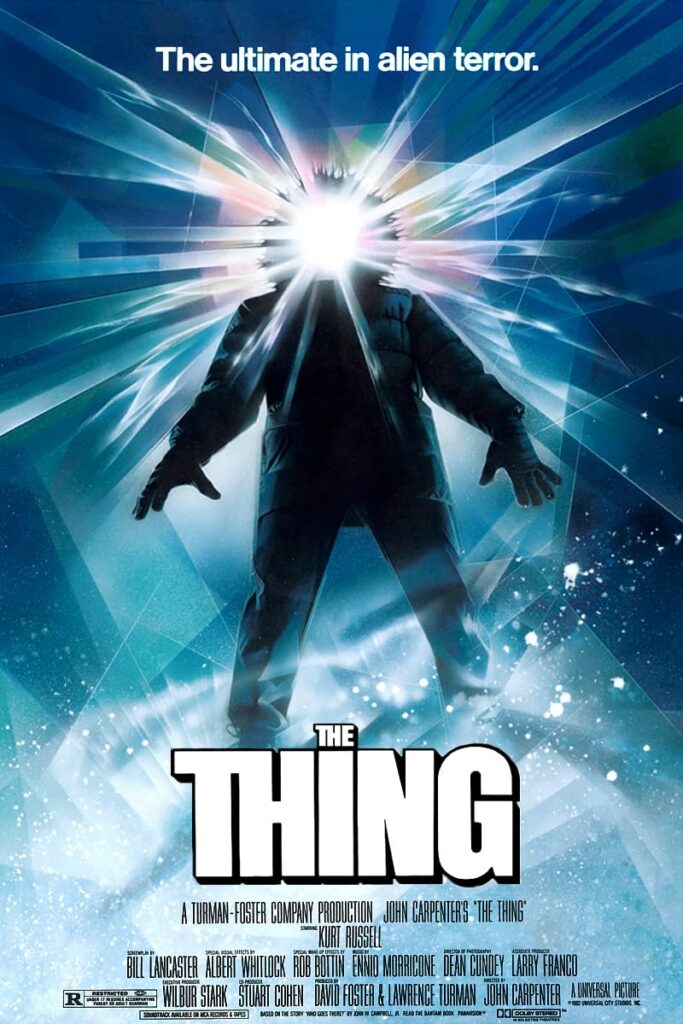
The Thing poster uses a chilling and highly detailed image of a grotesque and unnatural creature that dominates the frame. The tagline “Man is the warmest place to hide” plays on the theme of paranoia and fear, suggesting that even the people around you might not be what they seem. The creature, composed of melting and writhing flesh, is visually disturbing and symbolic of the horror that is central to the film.
The poster is effective because it conveys the central idea of the film: a shape-shifting alien parasite that can imitate any living being. The grotesque nature of the creature immediately sets the tone for the movie, while the tagline implies that anyone could be infected. It evokes a sense of distrust and tension, both of which are key themes throughout the film. The image of the creature combined with the tagline provides a strong visual warning of the terror to come.
This article originally appeared on Avocadu.
